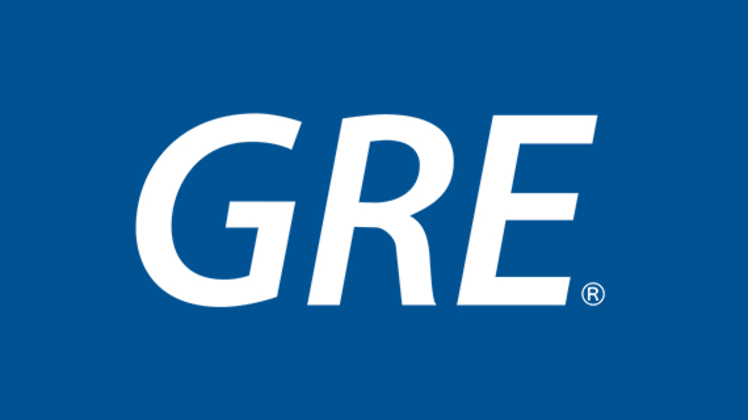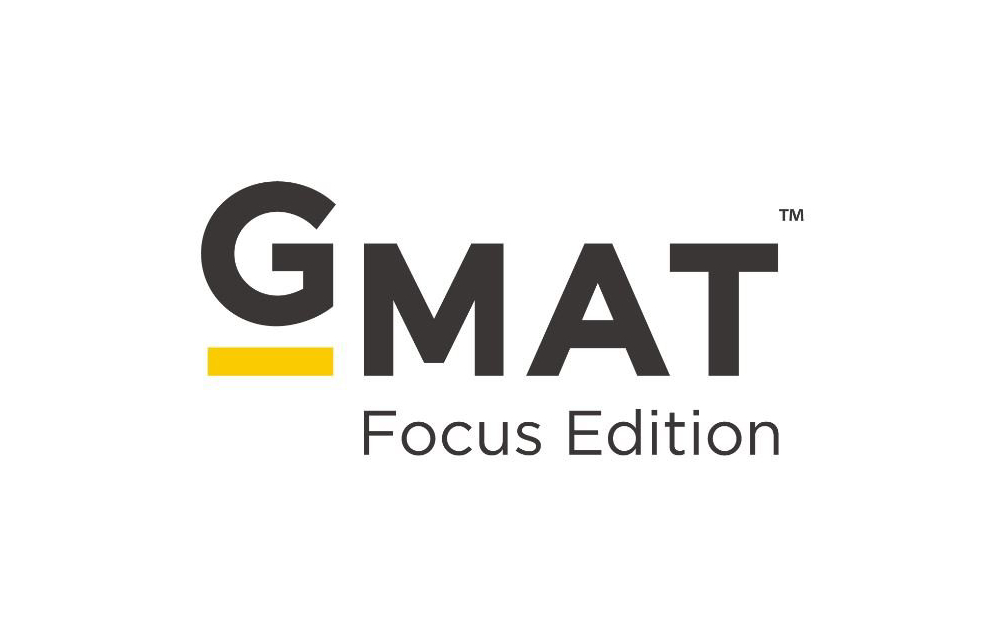
The ACT, or American College Testing, is a standardized test widely used for college admission in the United States. It serves as one of the factors considered in assessing a student’s academic readiness for admission and is usually taken during a student’s junior or senior year. The test is based on the high school curriculum and consists of multiple-choice questions that assess a student’s proficiency in core academic areas.
While the ACT is most commonly associated with admission to U.S. institutions of higher education, it is also recognized and accepted by a variety of international institutions of higher education. For example, some universities and colleges in countries such as Canada, Australia, the United Kingdom, Singapore, and the Netherlands may consider ACT scores in the application process, especially for international students. However, admission requirements may vary, so we recommend that you check with your specific institution.
Test format and structure
Beginning February 2024, ACT offers the option of taking the test in an online format. You can now choose whether you take the test on a computer or on paper.
The structure, questions, length, and results of the test remain the same no matter which way you choose.
The ACT consists of four required multiple-choice sections: English, Math, Reading, and Science.
In addition to these four sections, there is an optional Writing (Essay) section that assesses a student’s ability to analyze a given problem and develop an argument.
The English section consists of 75 questions and consists of several essays, or passages, each followed by a set of multiple-choice questions. This section assesses:
- understanding of the purpose and focus of the written work;
- understanding and control of the rhetorical aspects of the texts;
- determining the purpose of parts of texts;
- using a variety of strategies to ensure logical organization of the text;
- language proficiency;
- understanding of standard English grammar;
- understanding the structure and construction of sentences in a text;
- punctuation.
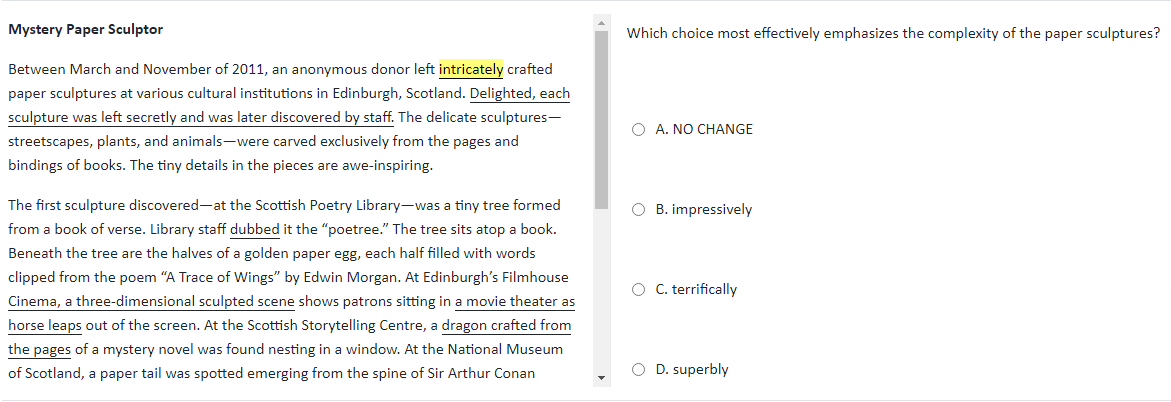
The Mathematics section consists of 60 questions and includes problems, graphs, mathematical examples, and geometry assignments, each followed by a set of multiple-choice questions. This section assesses:
- knowledge of geometry rules for lines, angles, circles, and polygons;
- knowledge of number properties (positive/negative numbers, even/odd numbers, divisibility);
- ability to calculate fractions, exponents, and radicals;
- understanding of formulas for percentages and percentage changes;
- understanding of strategies for: solving missing values in fractional proportions; multiplying binomials and factorizing quadratics; solving systems of linear equations, etc.
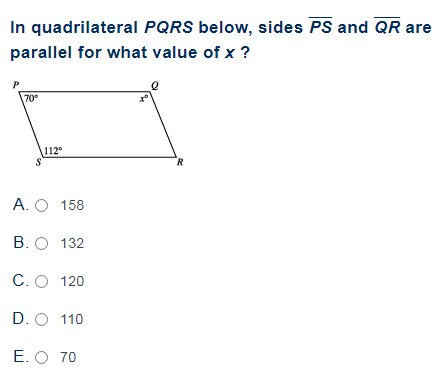
The Reading section consists of 40 questions and includes a long prose passage or several short passages, each followed by a set of multiple-choice questions. This section assesses:
- the ability to identify main ideas;
- finding and interpreting meaningful details;
- understanding the sequence of events, making comparisons;
- determining the meaning of words, phrases, and statements depending on context;
- the ability to analyze claims and evidence in arguments;
- integrating information from multiple texts.

The Science section consists of 40 questions and includes graphical and tabular material, descriptions and results of experiments, each followed by a set of multiple-choice questions. This section assesses:
- skills in recognizing relationships between data in tables and graphs, interpolation and extrapolation, and translating tabular data into graphs;
- interpretation of results;
- understanding, analyzing, and comparing alternative viewpoints or hypotheses.
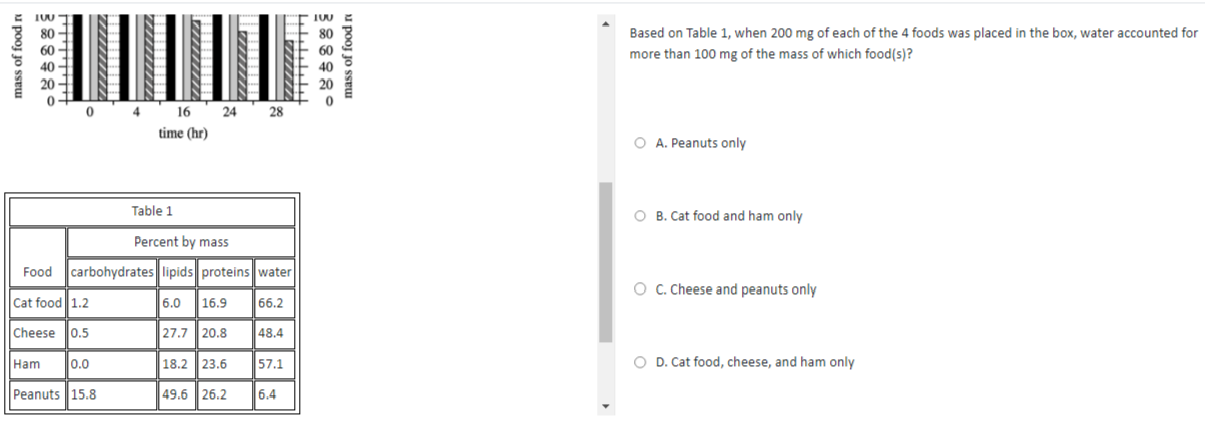
The Writing section consists of one writing assignment that describes a complex issue and provides three different perspectives on it. You are asked to read the assignment and write an essay in which you present your own perspective on the issue.
This section assesses the ability to:
- clearly articulate your own point of view on an issue and analyze the relationship between your point of view and at least one other point of view;
- develop and support their ideas with arguments and examples;
- present their thoughts clearly and logically;
- communicate effectively in standard written English.
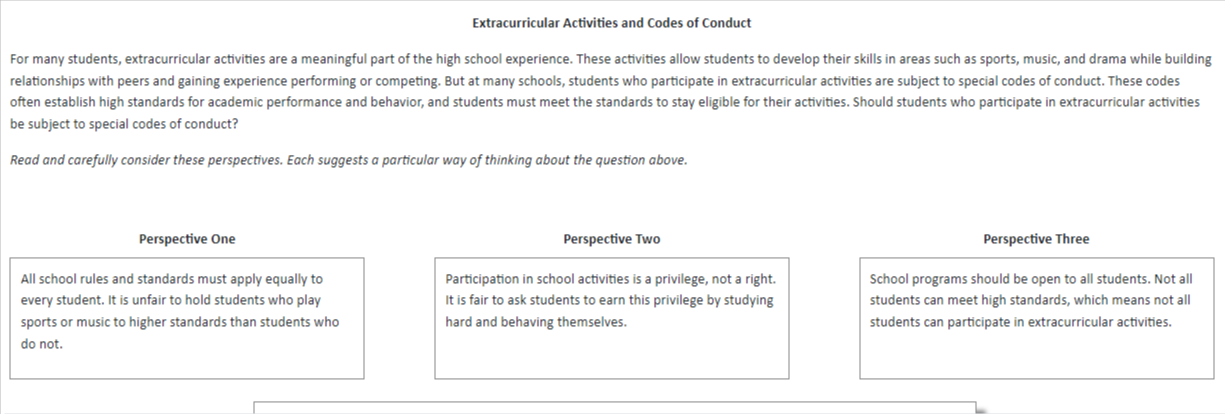

Whether you need help with math, science, languages, or any other subject, our tutors are ready to help you on your academic journey. Don’t miss your chance to succeed – take a discounted trial lesson today!
Registration for testing
To register for ACT, you will need to make an ACT web account.
To register, you will need:
- а computer with internet access;
- a credit card or other form of payment;
- high school course information, your high school code;
- a headshot;
- your parents’ email (optional).
During registration, you must also indicate your testing center, which colleges you would like to receive your ACT score report, select a test format, and indicate whether you will be taking the written portion.
You have the option to request accommodations or EL resources if you wish. But be sure to complete the process of requesting accommodations before the ACT registration deadline.
The ACT exam is offered seven times annually, with the registration deadline approximately one month before the test date. A late registration option is available until about two weeks later. Test-takers have the opportunity to take the ACT up to 12 times. Many students opt to take the test 2-3 times before embarking on their college journey. It is advisable to plan to take the test during your junior year in high school to allow for retesting once or twice if the desired score is not achieved initially.
The test is typically scheduled for the following periods:
- Fall of Junior Year: This is a popular time for a first attempt, allowing test-takers to establish a baseline score, identify areas for improvement, and plan subsequent preparation accordingly.
- Spring of Junior Year: Taking the ACT in the spring provides time to solidify the initial score and continue enhancing skills.
- Fall of Senior Year: If applying to colleges early, taking the ACT in the fall ensures that scores are available for applications. It also offers the opportunity to further improve scores, maximizing chances for scholarships.
There are various ways to take the ACT test:
- National Test Dates: Students can register for the ACT at open testing centers nationwide.
- ACT District Testing Program: This program, funded by the school or district, allows students to take the official ACT test during regular school hours on a weekday.
- Statewide Testing: In cases where districts do not conduct testing, some states fund official ACT tests administered in schools during regular hours. Details vary by state.
- College Campus Testing: Colleges can administer and score the ACT on campus any day of the week. Results are valid only at the college conducting the exam.
Testing process
The ACT comprises four mandatory multiple-choice tests, totaling 215 questions and lasting 2 hours and 55 minutes. The breakdown of time for each section is as follows:
- English Section: 45 minutes
- Math Section: 60 minutes
- Reading Section: 35 minutes
- Science Section: 35 minutes
If you opt for an additional written test, you will have an extra 30-40 minutes dedicated to crafting an essay.
After the math test, there is a 15-minute break, and an additional 5-minute break precedes the writing section.
Test-takers should aim to arrive at the testing center no later than 8 am, equipped with their admission ticket and ID card. Upon arrival, center staff will verify registration using the ID card and assign a seat in the testing room.
The mandatory test portion typically concludes around 12:15 pm, with the optional written section administered last, concluding by approximately 1:00 pm.
Supported devices at test centers include Chromebooks, desktops, and Windows laptops. Approved calculators are allowed but only during the Math section.
In the online test format, you will have access to tools such as:
- Index, which provides a list of questions;
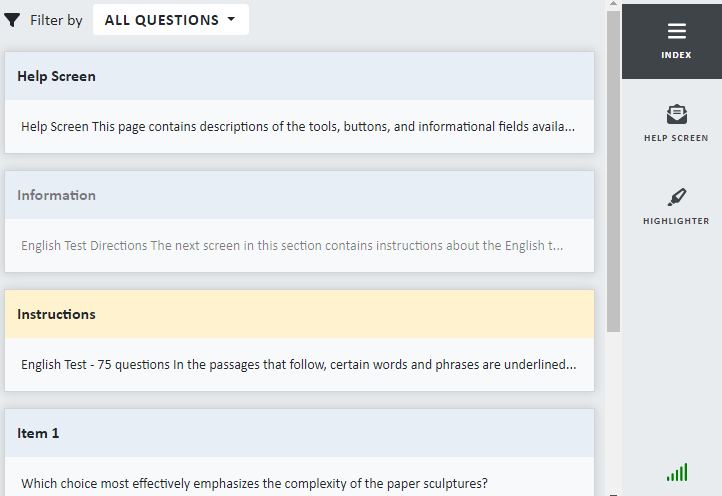
- Help screen;
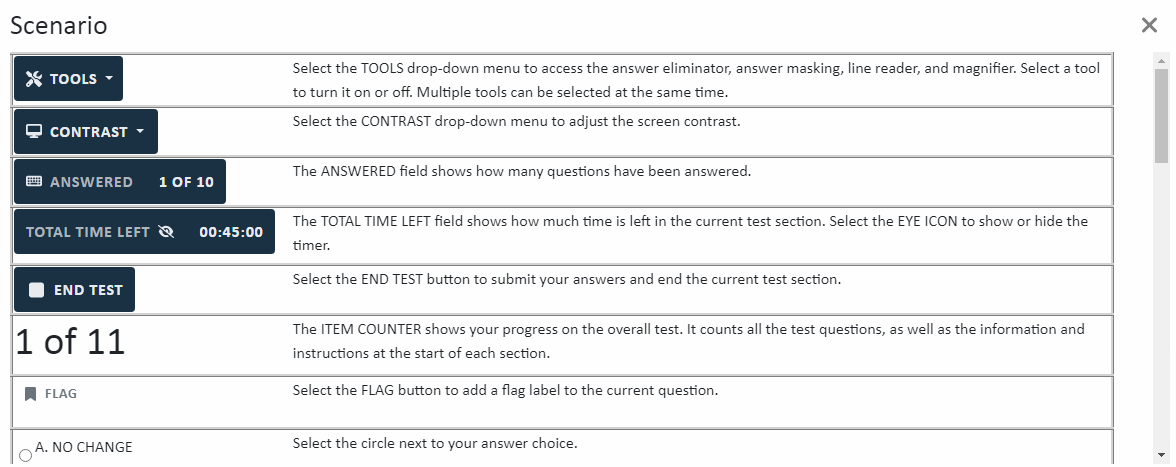
- Highlighter – to highlight a piece of text or a question;

- Magnifier, and a tool for reading, excluding, and masking answers;
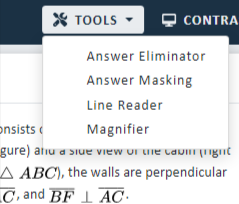
- Contarst to customize the screen;
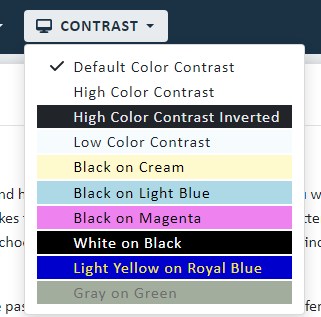
- A panel that displays the number of questions completed, the time, and the “END TEST” button.

- The circles next to each answer choice are for highlighting the correct answer.

Requirements for taking the test
Permissible Items to Bring:
- Admission Ticket. The ticket contains important enrollment information or an online launch code. You can print your admission ticket in MyACT;
- Photo ID. ID must be in hard plastic card format. Paper or electronic formats will NOT be accepted;
- Bring sharpened #2 pencils with good erasers;
- A watch, timer or stopwatch to keep track of time during testing, but no alarm clock;
- An approved calculator that can only be used on the math test. If you are taking the test online, the calculator is available in the testing platform, but you can still bring it with you;
- Snacks.
Prohibited Items During Testing:
- Mechanical pencils or ink pens, colored pens or pencils, correction fluid/tape;
- Textbooks, language dictionaries or other dictionaries, note paper, outlines, or other support materials;
- Any electronic devices other than an authorized calculator and an acceptable watch or timekeeper;
- Tobacco in any form;
- Weapons of any kind.
Assessment and test scores
ACT test scores are used for the following:
– better understanding and serving students;
– allocating scholarships and loans;
– evaluating the effectiveness of instruction;
– curriculum planning;
– college admissions;
– effective course placement.
The ACT is scored on a scale of 1 to 36 in each section in 1-point increments, and the overall composite score is the arithmetic mean of these four sections. The composite score also ranges from 1 to 36.
There are no penalties or point deductions for incorrect answers.
For example, there are 75 questions in the English section and you were able to answer 52 questions correctly. Your raw score would be 52, which is the total number of questions you answered correctly. Using the table below, we can estimate that a raw score of 52 corresponds to a scaled score of 22.
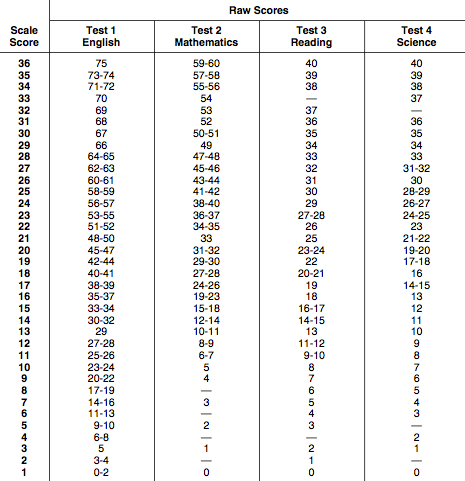
The optional section, “Writing (essay)”, is scored separately on a scale of 2 to 12 points. Two independent examiners score the essays on a scale of 1 to 6 in four areas: Ideas and Analysis, Development and Support, Organization, and Language Use.
Keep in mind, the Essay provides more information about your writing skills but does not affect your overall ACT score.
The perception of a “good” ACT score depends on the selectivity and academic standards of the schools you are considering. College admissions criteria vary: some colleges accept scores around 30, while others consider scores in the neighborhood of 20 to be acceptable.
Score range:
Below average: 1-16
Average score: 17-24
Above average scores: 25-36
Additionally, it’s essential to recognize that college admissions committees evaluate not only test scores but also factors such as grade point average, extracurricular activities, essays, and letters of recommendation.
ACT results can be viewed in your MyACT account. Multiple-choice test results should be available 2-8 weeks after the test date. Writing results are typically available approximately 2 weeks after the multiple-choice test results are available. ACT will prepare one score report for your ACT account, one for your school, and one for the colleges you indicated when you registered.
ACT test scores are valid for five years.
Importantly, you can request your ACT scores to be sent to other colleges and scholarship agencies even after completing the test.
Cost of the test
ACT (no writing portion) – $68 – Includes reports for you, your high school, and up to four colleges (if codes are provided at registration).
ACT (with writing portion) – $93 – Includes reports for you, your high school, and up to four colleges (if codes provided at registration).
Additional fees:
Change Test Option – $25 – You may add or remove a writing test before the MyACT registration deadline.
Fee to change test date or test center – $44
Late registration – $38.
Backup Testing – $68 – refundable if you are not allowed into the testing center on test day or registration is canceled due to missing a photo.
Score reports for 5th and 6th choice colleges – $18.50 (requested online prior to test date)
Additional score reports – $18.50
Test Information Release – $32 if ordered before the test / $40 if ordered after the test.
Score Verification – $58.00 Multiple Choice Test Verification / $58.00 Written Test Verification.
Supplementary Details
Beginning in September 2020, students are given the opportunity to retake certain sections of the ACT, which allows them to compile an “ACT Super Factor” that takes into account their best scores on all sections, even if they are from different exams. These retakes are administered exclusively digitally, and students may retake no more than three sections on any retake date, with a maximum of seven retakes per year and no lifetime limit. The introduction of digital administration also means that students can receive retake score reports as early as two days after testing. Higher ACT scores can be requested directly from a myACT account.
ACT offers students the ACT tuition waiver program:
- The program covers registration fees for the four ACT tests, including an additional writing test for the national test.
- At no additional cost, a Test Information Release (TIR) is provided to students so that they can familiarize themselves with the questions and answers.
- Students may also send unlimited additional ACT score reports to colleges and scholarship agencies at no charge.
- In addition, students who have waived fees may request a waiver or deferral of college application fees, which will allow them to receive financial aid for college admission.
To qualify for the ACT tuition waiver, students must be:
– Enrolled in high school in 11th or 12th grade;
– Be tested in the United States, U.S. territories, or Puerto Rico;
– meet indicators of economic need, such as participation in federal free or reduced-price lunch programs;
– live in special circumstances, such as foster care or federally subsidized public housing, or have family income at or below the USDA level for free or reduced-price lunches.




